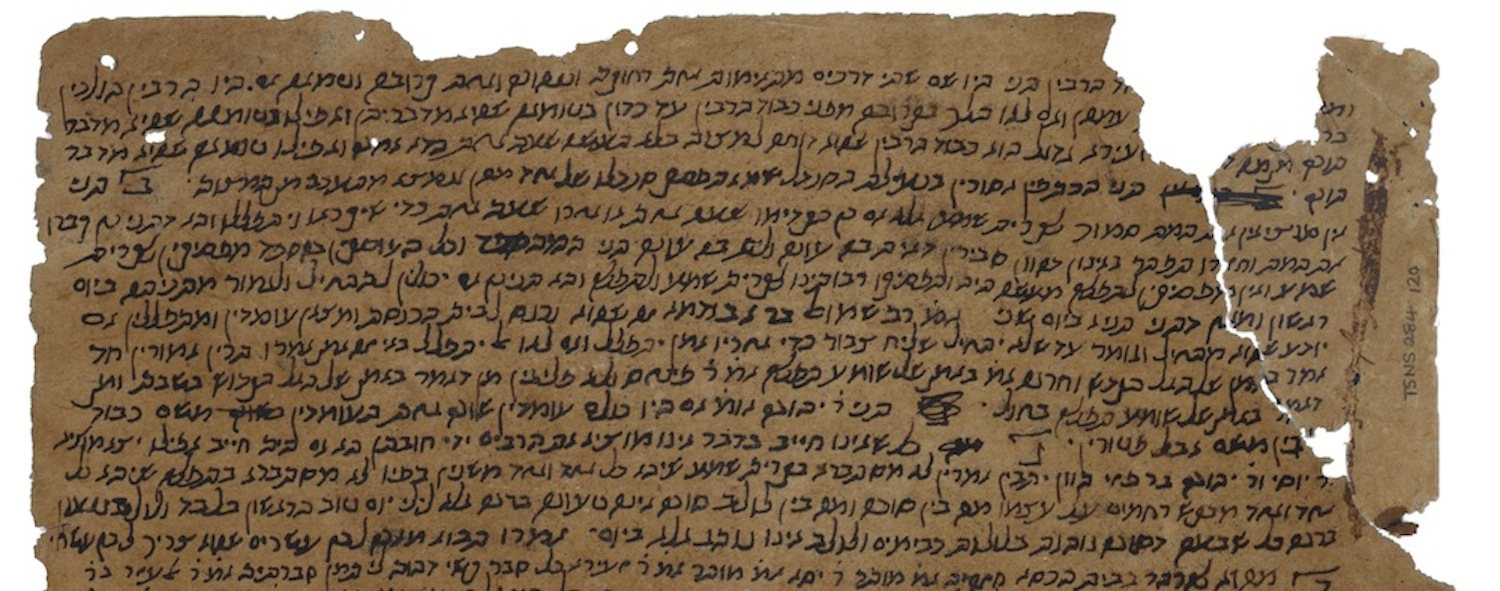A New Autograph of Hilkhot ha-Yerushalmi by Maimonides, T-S NS 284.120
By Zvi Stampfer
Hilkhot ha-Yerushalmi is one of Maimonides’ earliest works. When he was about thirty years old he completed the first draft of his commentary on the Mishnah, and while working on the final version he looked for a new project. His decision was to write a work concerning the Palestinian Talmud, and he called it Hilkhot ha-Yerushalmi, ‘The Laws of the Palestinian Talmud’. In one of his responsa, Maimonides explains his decision as wishing to follow in the footsteps of R. Isaac Alfasi, whose commentary on the Babylonian Talmud was widely used in the East. In light of the way the Palestinian Talmud was viewed by the sages in Andalusia, this was a logical step for Maimonides to take, completing Alfasi's omissions and writing a work that would present laws (halakhot) and commentaries in the Palestinian Talmud that were missing in the Babylonian.
After starting a first draft of Hilkhot ha-Yerushalmi and discussing the tractates of Berakhot and Ketubbot (and possibly also Qiddushin) Maimonides changed direction, however, abandoning this project to focus on writing his work Mishneh Torah. Because of this change he did not see any need to disseminate Hilkhot ha-Yerushalmi, and consequently the work was never published. In time the draft was put into the Genizah in Fustat, Maimonides’ place of residence. Over time, autograph sections of the draft have been discovered in the Genizah, and Prof. Saul Lieberman published a first edition of the work based on the fragments that were known to him.
These fragments of Maimonides' manuscript can aid research in three areas:
On the versions of the Palestinian Talmud: Copies of the Palestinian Talmud were rare even as early as the Middle Ages and only one complete manuscript is available to us today, the Leiden manuscript, which also underlies the editio princeps printed in Venice. In the course of his work, Maimonides copied whole sections of the Palestinian Talmud in its original language, and thus has handed down to us exact copies of parts of the Talmud text he used. This is probably the only other surviving witness to the original text of some passages, apart from the Leiden manuscript, and is more than a hundred years older. This manuscript, added to those at our disposal, is a treasure trove aiding the study of the Palestinian Talmud in general and of the Leiden manuscript in particular.
Understanding Maimonides in his Mishneh Torah: Maimonides did not quote his sources in the Mishneh Torah. His commentators often surmised that he based his laws on sources from the Palestinian Talmud, but it was impossible to verify this. Studying the Hilkhot ha-Yerushalmi can help clarify this matter.
Commentaries on the Palestinian Talmud: There are very few surviving commentaries on the Palestinian Talmud written in the Middle Ages. Hilkhot ha-Yerushalmi contains commentary by Maimonides on selected Talmudic issues.
To date the following fragments of Hilkhot ha-Yerushalmi have been identified and published:
One fragment from his work on tractate Berakhot: T-S F17.7. This page is almost complete apart from tears in two corners.
Two fragments from his work on tractate Ketubbot: T-S F17.7a and T-S Ar.34.169, which combined form about a third of the original page.
Two new fragments have been identified by Prof. Ya’akov Sussman, with whom I studied the Palestinian Talmud, and who has allowed me to publish them: Oxford Bodleian MS. Heb. e. 100.10 from Ketubbot and T‑S NS 284.120 from Berakhot, which is published here for the first time.
This new piece from Cambridge, T‑S NS 284.120, joins up perfectly with T-S F17.7 and completes the first nine lines on the recto and the first twelve lines on the verso. The completed lines match the reconstructed text originally suggested by Lieberman (with only slight changes). Studying this new section reveals an interesting aspect of the way Maimonides worked. On the verso he wrote a sentence along the length of the page and then crossed it out.* This additional sentence was written in a lighter coloured ink than that of the main body of the text and probably at a later date. Up until now it has been assumed that Maimonides completely abandoned this work, but from the new fragment we can see that he did return to it, at least once. The fragment (on the same side, in the fourth line) reveals another dilemma that Maimonides may have had while writing. He marked the beginning of a new law and started to copy from the Palestinian Talmud, tractate Berakhot 3:2, He then changed his mind, crossed out what he had written and added a question from 3:1 that he had originally intended to leave out. From these findings we can learn more about the way this work was written and the nature of the fragmentary draft that we have.
Amalgamated image of T-S F17.7 and the new discovery, T-S NS 284.120
* The crossed-out sentence is clearly in Maimonides’ hand, as this comparison with a similar word from T-S F17.7 shows:

Bibliography
Previous published fragments
Louis Ginzberg, Yerushalmi Fragments from the Genizah (New York, 1909), pp. 29–36.
J. N. Epstein, ‘Qitsur Yerushalmi Masekhet Berakhot’, Tarbiz 3 (1931–1932), pp. 7–12. [Hebrew]
Saul Lieberman, Hilkhot Ha-Yerushalmi (Hebrew; New York, 1974).
Simon Hopkins, ‘A new autograph of Maimonides’ Hilkhot Ha-Yerushalmi’, Journal of Semitic Studies 28 (1983), pp. 273–296.
A new edition of Hilkhot Ha-Yerushalmi on tractate Ketubbot can be found in
Zvi Stampfer, ‘Hilkhot Ha-Yerushalmi Ketubbot’, to be published in the jubilee volume in honor of Professor Rabbi N. E. Rabinovitz, edited by Zvi Heber and Carmiel Cohen (forthcoming 2011). [Hebrew]
Stampfer, Z. (2011). A New Autograph of Hilkhot ha-Yerushalmi by Maimonides, T-S NS 284.120. [Genizah Research Unit, Fragment of the Month, September 2011]. https://doi.org/10.17863/CAM.58100
If you enjoyed this Fragment of the Month, you can find others here.
Contact us: genizah@lib.cam.ac.uk

